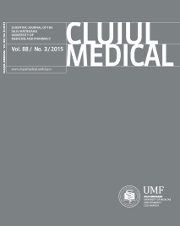RESISTANT HYPERTENSION IN TYPE 2 DIABETES: PREVALENCE AND PATIENT CHARACTERISTICS
DOI:
https://doi.org/10.15386/cjmed-441Keywords:
diabetes mellitus, hypertension, antihypertensive agents, diabetic complicationsAbstract
Background and aims. Resistant hypertension is defined as failure to achieve blood pressure lower than 140/90 mmHg when using three antihypertensive agents or controlled blood pressure with four or more drugs. We aimed at assessing the prevalence of resistant hypertension and to describe a type 2 diabetes population with resistant hypertension.
Methods. The retrospective observational study included (n=73) type 2 diabetes subjects with resistant hypertension selected from (n=728) subjects admitted to the Centre of Diabetes, Cluj, Romania.
Results. The subjects (70% women) had a mean age of 65.0±8.9 yrs. and diabetes duration 11(6-19) yrs. Prevalence of resistant hypertension was 10%. Chronic diabetes complications and cardiovascular disease were present in 77% and 56% of subjects respectively. On admission, antihypertensive drugs used were: angiotensin-converting enzyme inhibitors or angiotensin II receptors blockers 93%, β-blockers 88%, diuretics 78%, calcium channels blockers 59%, adrenergic α-antagonists 11%. Systolic and diastolic blood pressure were lower in the last compared to first admission day. Diuretics and calcium channels blockers were the most frequently newly added antihypertensive agents.
Conclusion. Although the prevalence of resistant hypertension in type 2 diabetes did not differ from the general population, we observed that these patients had increased frequency of chronic diabetic complications. Angiotensin-converting enzyme inhibitors or angiotensin II receptors and β-blockers were the most used antihypertensive drugs, while the most frequently newly prescribed drugs were diuretics and calcium channel blockers.
Downloads
Additional Files
Published
How to Cite
Issue
Section
License
The authors are required to transfer the copyright of the published paper to the journal. This is done by agreeing to sign the Copyright Assignment Form. Whenever the case, authors are also required to send permissions to reproduce material (such as illustrations) from the copyright holder.

The papers published in the journal are licensed under a Creative Commons Attribution-NonCommercial-NoDerivatives 4.0 International License.

